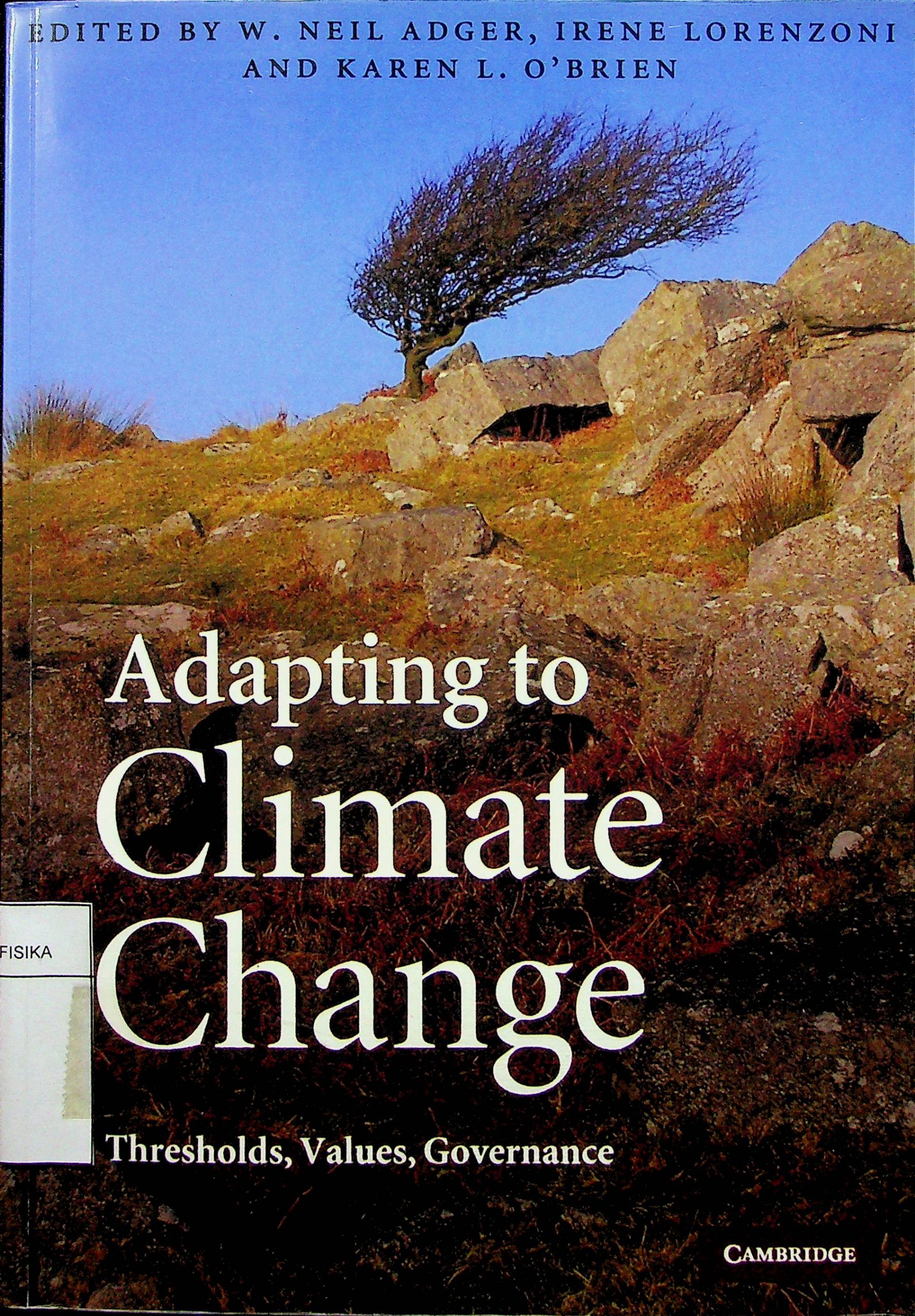Almost every day new scientific evidence suggests that the climate is changing due to human action and will continue to change over our lifetimes and those of the next generations. It would be inconceivable that humans, as the most adaptable of species, would not adapt to this challenge. But the state of science about how and whether we adapt and the cost and consequences of such adaptations is nowhere near that of science of atmospheric change. Of course, societies adapt all the time to diverse risks and challenges. So, drawing on theoretical and empirical research, we should be able to discern how adaptation to a changing climate will proceed. Herein lies the impetus for this book.Until recently, adaptation has been somewhat sidelined, or some would say, actually tabooed, in the climate change discourse. Many argue that investing in adapting to the impacts distracts from the major task of mitigating the causes of anthropogenic climate change by reducing greenhouse gas emissions. Others are convinced that adaptation will automatically happen, once environmental changes become visible. But the time for adaptation action has arrived and the demand for information and rigorous science in this area is increasing exponentially. The funding for adaptation research is growing, and so are the questions that need to be addressed. Many of these questions are directly related to the process of adaptation, and to one overarching question: can we live with climate change In this book we examine whether there are real limits and constraints to adapt Ing to the impacts of climate change that is already observed and which is projected for the future. The book is interdisciplinary because adaptation involves deliberate changes and decision-making about resources, values and priorities. The volume spans the natural sciences related to climate change and ecological change, as well as social science analysis of decision-making, involving contributions from economics, anthropology, political science and human geography. Taken together, the chapters paint an illuminating picture of historical,contemporary and future adaptation actions, and draw on work from the developing world, Europe and the Americas, as well as the international policy landscape. We show that adaptation is necessary, but also fraught with difficulties and challenges. Adaptation in ecosystems and in society will not advance in a smooth manner in response to slow trends in climate parameters such as temperature. Rather it is a messy business involving societal decision-making, attitudes to acceptable risks, and structural constraints within society. The scale of the necessary transformations of societies and economies to face the coming climate change is enormous. Even if rigorous greenhouse gas mitigation efforts are pursued, the climatic changes that are anticipated to occur over the next decades will require changes in infrastructure, in behaviour and more fundamentally, in society’s relationship with its environment. This book shows that even moderate levels of climate change can be difficult to adapt to due to constraints in physical and biological systems, due to culture and values in making collective decisions, and due to inertia in governance systems. Questions of whether and how adaptation will occur have been central to our own research over the past five years. We have helped to steer two major research programmes: the adaptation programme of the Tyndall Centre for Climate Change Research in the UK and the project on the Potentials of and Limits to Adaptation in Norway (PLAN), funded by the Research Council of Norway. We also worked closely together in the IPCC Fourth Assessment Report on adaptation, where we became more convinced that adaptation is severely limited if it is to be the head-in-the-sand, primary response to the coming climate crisis. As we presented this work inNorway, in the UK and internationally, we realised that although adaptation occurs around the world in very different historical, cultural and policy contexts, the processes, the constraints and the ways forward for sustainable action are common to all. We convened a conference at the Royal Geographical Society in London in February 2008 on this topic. The resulting papers, selected through rigorous peer review, are the basis of this book. We thank the funding bodies of our underlying research, and of the conference from which this book derives for support. In the UK these are the research councils who support the Tyndall Centre: Natural and Environment Research Council, Engineering and Physical Science Research Council and the Economic and Social Research Council. In Norway, the research and conference was supported by the Research Council of Norway’s NOR KLIMA programme. Internationally, the conference was supported by the Global Environmental Change and Human Security (GECHS) project of the IHDP. We thank colleagues and supporters of the PLAN and GECHS projects, who recognise that understanding adaptation to climate change in any particular place requires an international research endeavour. We also thank colleagues in the Tyndall Centre, particularly Nigel Arnell, Emma Tompkins, Mike Hulme and the present adaptation team for stimulation and discussions over the years. The Tyndall Centre is unique in its spirit of scientific openness and true interdisciplinarity - traits that deserve nurturing and preservation. We thank the participants to the conference, and especially extend our thanks to many within our organisations who contributed to the production of this book and for stimulating the scientific learning and refinement that occurred at the conference. These include Jacquie Gopal, Vanessa McGregor, Helen Adams, Lauren Roffey, Anita Wreford, Saleemul Huq, Mike Hulme, Diana Liverman, Andrew Watkinson, Bo Kjellen, Chris West, Roger Street, Siri Mittet, Asher Minns, Linda Sygna and Kirsten Ulsrud. We also thank our colleagues in the IPCC, particularly Shardul Agrawala, Monirul Mirza, Cecilie Conde, Juan Pulhin, Roger Pulwarty, Barry Smit and Kyoshi Takahashi, as well as colleagues in the Tyndall Centre for discussions which initially stimulated our thoughts towards this volume. Finally we thank Professor Bob Watson of the Tyndall Centre for his contribution to the Royal Geographical Society conference and for encouragement towards seeking the messages for policy and government from this endeavour.
5
ADAPTING TO CLIMATE CHANGE
W. NEIL ADGER, IRENE LORENZONI AND KAREN L. O’BRIEN
Penerbit :
Cambridge University Press
Tahun :
2009
Buku Text
Ekologi
-
No Scan13
-
No Klasifikasi551.6
-
ISBN-
-
ISSN-
-
No Registrasi012B012016
-
Lokasi Terbit-
-
Jumlah Hal146
-
Label551.6 Nei a
-
Versi DigitalYA
-
Versi FisikYA
-
Lokasi Rak Buku Fisik01/B/11
-
Jumlah Exemplar Fisik Tersedia1






